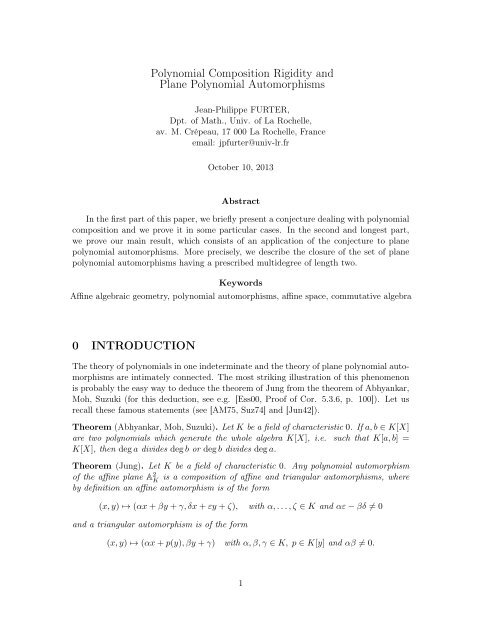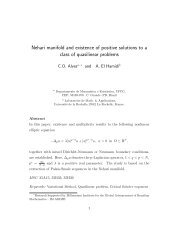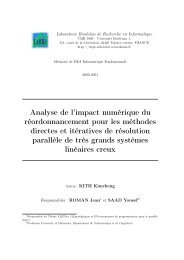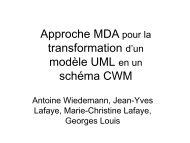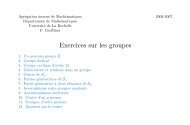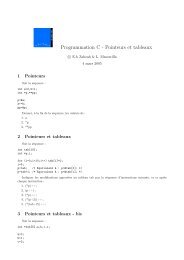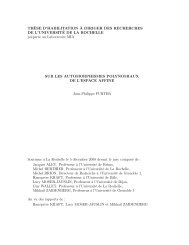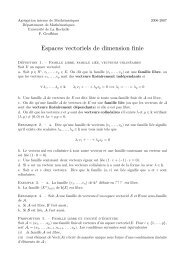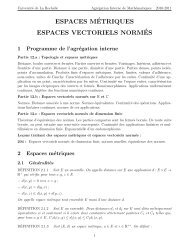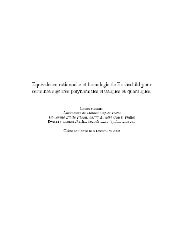Polynomial Composition Rigidity and Plane Polynomial ...
Polynomial Composition Rigidity and Plane Polynomial ...
Polynomial Composition Rigidity and Plane Polynomial ...
Create successful ePaper yourself
Turn your PDF publications into a flip-book with our unique Google optimized e-Paper software.
Remark. We would like to stress that even if the conjecture R(m, n) is obvious whenm or n = 1 (cf. the proof of conjecture R(1) in subsection 1.4), its consequence forpolynomial automorphisms (given via Theorem B) is not obvious at all. Indeed, it assertsthat if d = (d 1 , d 2 ) is a multidegree such that d 1 or d 2 ≤ 2, then G d = ⋃G e . Thesimplest case where d 1 = d 2 = 2 means thatG (2,2) = G ∅ ∪ G (2) ∪ G (3) ∪ G (2,2) .In particular, this equality implies the two following points:• G (3) ∩ G (2,2) ≠ ∅. As explained above, this point can be established using the familyof plane automorphisms induced by the Nagata automorphism;• G (2,2) ∩ G (4) = ∅. This equality follows from [Fur09, Th. A] asserting that forany multidegree d = (d 1 , . . . , d l ), the set G d is closed in the set of all automorphisms ofdegree d 1 . . . d l . The weaker fact that G (4) is not included into G (2,2) was a consequenceof [Fur97, Th. 2] <strong>and</strong> was also the object of [Fur97, Prop. 12].As a funny consequence of Th. C, we will show:Theorem D. Any closed subgroup of G containing the affine group <strong>and</strong> an automorphismof length 1 is equal to G.Remark. 1. Let us note that any subgroup of G strictly containing the affine group isdense in G for the Krull topology (see [Fur07, Th. A]). This means that any element ofG can be approximated at the origin <strong>and</strong> at any order by an element of this subgroup.2. We recall that any closed subgroup of G which is a finite dimensional algebraicvariety is conjugate to either a subgroup of A or B (see [Sha66, Th. 8], [Kam79, Th.4.3] or [GD75, Th. 7]).We finish this introduction by the following natural question.Question. Does there exist a non trivial closed subgroup of G containing the affine group?This paper is divided into two parts. The first part is the shortest one <strong>and</strong> is onlycomposed of section 1, where we study the rigidity conjecture R(m, n) <strong>and</strong> prove Th. A.The second part is composed of the three sections 2, 3, 4. In section 2, we give somepreliminary results. In sections 3 <strong>and</strong> 4, we respectively prove Th. B <strong>and</strong> Th. D.1 THE RIGIDITY CONJECTUREIn subsection 1.1 we prove that the conjectures R(m, n) <strong>and</strong> R(n, m) are equivalent. Insubsection 1.2, we relate the conjectures R(m, n) <strong>and</strong> R(m). In subsection 1.3, we givesome generalities on the conjecture R(m). In subsection 1.4, we prove the conjecturesR(1) <strong>and</strong> R(2). In subsection 1.5, we give some information on the conjecture R(3). Weexplain why we were not able to solve it <strong>and</strong> hope that the given information might helpor motivate some reader for further investigations.e ≼ d6
1.1 The conjecture R(m, n) <strong>and</strong> R(n, m) are equivalentLemma 1. The conjectures R(m, n) <strong>and</strong> R(n, m) are equivalent.Proof. Let val: C((X)) → Z ∪ {+∞} be the valuation associated to the discrete valuationring C[[X]]. The conjecture R(m, n) means that if a = X(1 + a 1 X + · · · + a m X m ) <strong>and</strong>b = X(1 + b 1 X + · · · + b n X n ) are such that val(a ◦ b − X) ≥ m + n + 2, then a = b = X.Therefore, it is enough to check that val(a ◦ b − X) = val(b ◦ a − X). Indeed, ifk = val(a ◦ b − X), we have a ◦ b(X) ≡ X mod X k . Let a −1 (X) ∈ C[[X]] be the formalinverse of a for the composition. We get a −1 ◦ (a ◦ b) ◦ a(X) ≡ a −1 ◦ a(X) mod X k , i.e.b ◦ a(X) ≡ X mod X k , so that val(b ◦ a − X) ≥ val(a ◦ b − X). We would show theother inequality in the same way, so that finally val(a ◦ b − X) = val(b ◦ a − X).1.2 Relations between the conjectures R(m, n) <strong>and</strong> R(m)Lemma 2. If m ≥ 1, the two following assertions are equivalent:i) The conjecture R(m, n) holds for any n ≥ 0;ii) The conjecture R(m) holds.Proof. If a = X(1 + a 1 X + · · · + a m X m ) ∈ C[X], let us set⎛⎞a −1 = X ã k X k ⎠ ∈ C[[X]].⎝1 + ∑ k ≥ 1By definition, the conjecture R(m) holds if <strong>and</strong> only if for any integer n ≥ 0 the followingassertion ˜R(m, n) holds:Assertion ˜R(m, n). (ã n+1 = · · · = ã n+m = 0) =⇒ a(X) = X.However, if b = X(1 + b 1 X + · · · + b n X n ) ∈ C[X], we have:a ◦ b(X) ≡ X mod X m+n+2 ⇐⇒ a −1 (X) ≡ b(X) mod X m+n+2 .Using this equivalence, let us show that the assertions ˜R(m, n) <strong>and</strong> R(m, n) are equivalent.This will be enough for showing the lemma.Assume that the conjecture R(m, n) holds <strong>and</strong> that we have ã n+1 = · · · = ã n+m = 0.Set⎛b(X) = X ⎝1 +∑1 ≤ k ≤ nã k X k ⎞⎠ = X⎛⎝1 +∑1 ≤ k ≤ m+nã k X k ⎞⎠ .We get a −1 (X) ≡ b(X) mod X m+n+2 , so that a ◦ b(X) ≡ X mod X m+n+2 <strong>and</strong> finallya(X) = X.Assume that the assertion ˜R(m, n) holds <strong>and</strong> that we have a◦b(X) ≡ X mod X m+n+2 .Then, we have a −1 (X) ≡ b(X) mod X m+n+2 , so that ã n+1 = · · · = ã n+m = 0 <strong>and</strong> weget a(X) = X. The equality b(X) = X follows at once.7
1.3 Generalities on the conjecture R(m)Let m ≥ 1 be a fixed integer. Set a(X) = X(1 − λ 1 X) . . . (1 − λ m X) ∈ C[X], where theλ k are complex numbers, <strong>and</strong> express the formal inverse for the composition of a as⎛⎞a −1 (X) = X ⎝1 + ∑ u nn + 1 Xn ⎠ ∈ C[[X]],n≥1where the u n , n ≥ 1, are complex numbers.Lemma 3. If ∮ denotes integration over a little circle around the origin, we haveu n = 1 ∮dX2πi a n+1 (X) =∑( ) ( )n + j1 n + jm. . . λ j 1nn 1 . . . λ jm m .j 1 + ··· + j m = nProof. By Lagrange formula, we have:u n = n + 1 ∮ a −1 ∮(X) n + 1 YdX =2πi Xn+2 2πi a n+2 (Y ) a′ (Y )dY by setting X = a(Y );= 1 ∮2πidYa n+1 (Y )by integrating by parts.∏Therefore, u n is the X n 1-coefficient of the formal series∈ C[[X]].(1 − λ k X) n+11 ≤ k ≤ m1We conclude thanks to the Taylor expansion(1 − X) n+1 = ∑ ( ) n + jX j .nj ≥ 0Note that u n is a homogeneous polynomial of degree n in the λ 1 , . . . , λ m (where eachλ k has weight 1). The conjecture R(m) means that if m consecutive u n vanish, thenthe λ i also. In other words, m consecutive polynomials u n always constitute a hsop ofC[λ 1 , . . . , λ m ].Remark 4. In order to prove R(m), it is sufficient to prove that if m consecutive u nvanish, then u k = 0 when k is large enough. Indeed, in this case a −1 is a polynomial <strong>and</strong>the relation X = a ◦ a −1 shows that a = X (by taking the degree).The proof of the following lemma is due to Laurent Manivel.Lemma 5. The sequence n ↦→ u n satisfies a linear recurrence relation with polynomialcoefficients of length m. More precisely, there exist polynomials µ 0 (n), . . . , µ m (n) inC[λ 1 , . . . , λ m ][n], not all zero, such that∀ n ≥ 1,∑0 ≤ k ≤ mµ k (n) u n+k = 0.8
Proof. By Lemma 3, it is enough to show an analogous linear recurrence relation for thesequence∮dXn ↦→ v n :=a n (X) .⎛ ⎞∮ vXkn,0Set v n,k =a n dX <strong>and</strong> V ⎜ ⎟n = ⎝ . ⎠ .v n,m−1Claim. There exists a square matrix M n whose entries belong to the field C(λ 1 , . . . , λ m )(n)such thatV n = M n V n+1 .∮ XSet γ(X) = X −1 k−na(X) = (1 − λ 1 X) . . . (1 − λ m X). We have v n,k =γ n dX. If∮n X k−n+1 γ ′k ≠ n − 1, we get v n,k =k − n + 1 γ n+1 dX, i.e.k − n + 1n∮ X k−n+1 γ ′v n,k =dX.γ n+1Note that this last equality still holds for k = n − 1. By Euclidean division, there existpolynomials A k , B k such thatX k+1 γ ′ = A k γ − B k<strong>and</strong> we have deg A k = k <strong>and</strong> deg B k < deg γ = m. We have:∮k − n + 1 X −n ∮ ∮(A k γ − B k ) Akv n,k =nγ n+1 dX =a n dX − XBkdX.an+1 This gives us a relation of the following form:∮But we haven − k − 1nv n,k +k∑a k,j v n,j =j=0a ′ma n+1 dX = 0 <strong>and</strong> a(X) = X ∑σ k =∑k=0m∑b k,j v n+1,jj=1i 1
This relation allows us to express v n+1,m in terms of the v n+1,j ’s, 0 ≤ j ≤ m − 1. Bymaking such a substitution in the right h<strong>and</strong> side of (*), we obtain a relation of the formn − k − 1nv n,k +k∑a k,j v n,j =j=0m−1∑j=0c k,j v n+1,j(∗ ∗ ∗).However, the relations (***) for 0 ≤ k ≤ m − 1 can be expressed with matrices asK n V n = CV n+1 ,where the matrix C does not depend on n, i.e. has entries in C(λ 1 , . . . , λ m ), <strong>and</strong> thematrix K n is lower triangular with diagonal entries the numbersn − k − 1n+ a k,k = n − k − 1n+ m, 0 ≤ k ≤ m − 1.In particular, the matrix K n is invertible. By setting M n := Kn−1 C, we have proved theclaim.By using several times the claim, we get:V n+m = V n+mV n+m−1 = M n+m−1 V n+m.V n = (M n M n+1 . . . M n+m−1 )V n+m .Therefore, the m + 1 elements v n , . . . , v n+m can be expressed as linear combination, withcoefficients in C(λ 1 , . . . , λ m )(n), of the m elements v n+m,0 , . . . , v n+m,m−1 . As a consequence,the elements v n , . . . , v n+m are linearly dependent over the field C(λ 1 , . . . , λ m )(n)<strong>and</strong> hence also over the ring C[λ 1 , . . . , λ m ][n].1.4 Proof of theorem AAccording to Lemmas 1 <strong>and</strong> 2, it is sufficient to prove the conjectures R(1) <strong>and</strong> R(2).a) Proof of R(1)We use the notations of subsection 1.3 with m = 1. Note that u n = ( )2nn λn1 . If u n = 0,we want to prove that λ 1 = 0. This is obvious.□b) Proof of R(2)We use the notations of subsection 1.3 with m = 2. Note that:u n =∑ ( )( )n + i n + jλ in n1λ j 2 .i + j = nWe rely on the following linear recurrence relation.10
µ 2 = (σ1 2 − 2σ 2)(2σ1 2 − 6σ 2) + σ 1 (7σ 1 σ 2 − 2σ1 3)= −3 σ 2 (λ 1 − λ 2 ) 2µ 1 = 3 σ 1 σ 2 (6σ 2 − 2σ1 2) − 3 3n − 2n= 3 σ 1 σ 2 (9σ 2 − 2σ1 2) 2n − 1n= 3 σ 1 σ 2 (λ 1 − 2λ 2 )(λ 2 − 2λ 1 ) 2n − 1nµ 0 = 3 2 σ 3 23n − 2n3n − 4n − 1 .Since v k+1 = 2πi u k for any k, the result follows.σ 1 σ2 2 − 3 3n − 1 (7σ 1 σ 2 − 2σ1 3 n)σ 2Remark 7. Another way to prove Lemma 6 is more elementary, but tedious. The lefth<strong>and</strong> side being homogeneous of degree n + 2 in λ 1 , λ 2 , it is enough to check that for0 ≤ i ≤ n + 2, the coefficient of λ i 1 λn+2−i 2 vanish.Let us prove R(2). If u k = u k+1 = 0, we want to prove that λ 1 = λ 2 = 0. Webegin by showing by contradiction that λ 1 = λ 2 . Otherwise, Lemma 6 shows us that thefollowing implication holds:∀ n ≥ 3, (u n−2 = u n−1 = 0) =⇒ u n = 0.Therefore, u n = 0 for n ≥ k <strong>and</strong> by Remark 4, this implies the equality λ 1 = λ 2 = 0. Acontradiction. Therefore λ 1 = λ 2 . Set λ := λ 1 = λ 2 . Lemma 6 gives us for any n ≥ 3:2(n − 1)(2n − 1)λ 3 u n−1 − 3(3n − 4)(3n − 2)λ 4 u n−2 = 0.Let us show by contradiction that λ = 0. Otherwise, the following implication wouldhold:∀ n ≥ 3, u n−2 = 0 =⇒ u n−1 = 0.We still get u n = 0 for n ≥ k, so that λ = 0. A contradiction. We have indeed λ = 0, sothat λ 1 = λ 2 = 0.□1.5 The conjecture R(3).The first aim of this subsection is to explain why we were not able to solve conjectureR(3) in the previous way. The second aim is to give some information (<strong>and</strong> motivation)for the reader who might be interested to undertake some investigations on this subject.We use the notations of subsection 1.3 with m = 3, so that:∑( )( )( )n + i n + j n + ku n =λ in n n1λ j 2 λk 3 ∈ Z[λ 1 , λ 2 , λ 3 ].i + j + k = nBefore giving the linear recurrence relation satisfied by the u n , we need some notations.If µ = (µ 1 , µ 2 , µ 3 ) where µ i are integers satisfying µ 1 ≥ µ 2 ≥ µ 3 ≥ 0, we define m µ ∈Z[λ 1 , λ 2 , λ 3 ] by m µ := ∑ λ ν 11 λν 22 λν 33 where (ν 1, ν 2 , ν 3 ) describes all distinct permutations12
of the triple (µ 1 , µ 2 , µ 3 ). We identify (µ 1 , µ 2 ) <strong>and</strong> (µ 1 , µ 2 , 0) as well as (µ 1 ) <strong>and</strong> (µ 1 , 0, 0).Hence m (1) = λ 1 +λ 2 +λ 3 , m (1,1) = λ 1 λ 2 +λ 1 λ 3 +λ 2 λ 3 , m (1,1,1) = λ 1 λ 2 λ 3 <strong>and</strong> m (3,2,1) =λ 3 1 λ2 2 λ 3 + λ 3 1 λ 2λ 2 3 + λ2 1 λ3 2 λ 3 + λ 1 λ 3 2 λ2 3 + λ2 1 λ 2λ 3 3 + λ 1λ 2 2 λ3 3 .We set ∆ = (λ 1 − λ 2 ) 2 (λ 1 − λ 3 ) 2 (λ 2 − λ 3 ) 2 <strong>and</strong> define the M i , N i for 1 ≤ i ≤ 5 by:M 1 = 9m (4,2) − 14m (4,1,1) − 9m (3,3) + 3m (3,2,1) − 3m (2,2,2) ;M 2 = 5m (4,2) − 8m (4,1,1) − 5m (3,3) + 2m (3,2,1) − 3m (2,2,2) ;M 3 = 39m (4,2) − 62m (4,1,1) − 39m (3,3) + 15m (3,2,1) − 21m (2,2,2) ;M 4 = 33m (4,2) − 52m (4,1,1) − 33m (3,3) + 12m (3,2,1) − 15m (2,2,2) ;M 5 = 6m (4,2) − 10m (4,1,1) − 6m (3,3) + 3m (3,2,1) − 6m (2,2,2) ;N 1 = −2m (5,2) + 4m (5,1,1) + 3m (4,3) − 3m (4,2,1) − 8m (3,3,1) + 8m (3,2,2) ;N 2 = 10m (9,4) −36m (9,3,1) +52m (9,2,2) −25m (8,5) +63m (8,4,1) −38m (8,3,2) +10m (7,6) +30m (7,5,1) − 146m (7,4,2) + 216m (7,3,3) − 60m (6,6,1) + 70m (6,5,2) − 32m (6,4,3) − 60m (5,5,3) +40m (5,4,4) ;N 3 = −27m (4,4) + 36m (4,3,1) − 2m (4,2,2) − 52m (3,3,2) ;N 4 = −342m (8,6) +1006m (8,5,1) −1110m (8,4,2) +972m (8,3,3) +342m (7,7) −141m (7,6,1) −1301m (7,5,2) + 900m (7,4,3) + 1178m (6,6,2) − 15m (6,5,3) − 724m (6,4,4) + 238m (5,5,4) ;N 5 = 10m (8,6) −30m (8,5,1) +34m (8,4,2) −30m (8,3,3) −10m (7,7) +5m (7,6,1) +37m (7,5,2) −27m (7,4,3) − 38m (6,6,2) + 5m (6,5,3) + 20m (6,4,4) − 10m (5,5,4) .Set:A n = n(n − 1)(n − 2)(M 1 n − 3M 2 )∆;B n = (n − 1)(n − 2)[(2M 1 n 2 − M 3 n)N 1 − 3N 2 ];C n = (n − 2)[(M 1 n 3 − M 4 n 2 )N 3 + 3nN 4 + 36N 5 ];D n = 8(2n − 3)(4n − 7)(4n − 9)(M 1 n − M 5 )m 3 (1,1,1) .One could show the next result (using a computer!):Lemma 8. For any n ≥ 4, we have:A n u n + B n u n−1 + C n u n−2 + D n u n−3 = 0.The difference with the recurrence relations obtained in Lemma 6 is that the factorM 1 n − 3M 2 of A n may suddenly vanish for a large value of n. Therefore, if we assumethat u k = u k+1 = u k+2 = 0, we do not succeed to show that u k+3 = 0. However, a closeranalysis of the recurrence formula might probably be sufficient for proving R(3).2 PRELIMINARY RESULTSIn subsection 2.1, we recall a valuative criterion characterizing the elements of f(V ) wheref : V → W is a morphism of complex algebraic varieties. The only valuation ring we needis the ring of complex formal power series. In subsection 2.2, after recalling equivalentdefinitions of a hsop, we give two results related with formal power series. In subsection2.3, we make some technical definitions which will allow us (in the next section) to proveTh. B. Finally, in subsection 2.4, we prove an easy lemma on the multidegree.13
2.1 Valuative criterionThe valuative criterion given in Lemma 9 below is familiar (e.g. [MFK94, chap. 2, § 1,pp 52-54] or [Gro61a, § 7]). We proved it in [Fur09].Let C[[T ]] be the algebra of complex formal power series <strong>and</strong> let C((T )) be its quotientfield. If V is a complex algebraic variety <strong>and</strong> A a complex algebra, V (A) will denote thepoints of V with values in A, i.e. the set of morphisms Spec A → V . If v is a closed(C((T )))point of V <strong>and</strong> ϕ ∈ V , we will write v = lim ϕ(T ) when:T →0i) the point ϕ : Spec C((T )) → V is a composition Spec C((T )) → Spec C[[T ]] → V ;ii) v is the point Spec C → Spec C[[T ]] → V .( )For example, if V = A 1 <strong>and</strong> ϕ ∈ V C((T ))when ϕ ∈ C[[T ]] <strong>and</strong> v = ϕ(0).= C((T )), we will write v = limT →0ϕ(T )Lemma 9. Let f : V → W be a morphism of complex algebraic varieties <strong>and</strong> let w bea closed point of W . The two following assertions are equivalent:i) w ∈ f(V );( )ii) w = lim f(ϕ(T )) for some ϕ ∈ V C((T )) .T →0Remark. Note the analogy with the metric case where w ∈ f(V ) if <strong>and</strong> only if thereexists a sequence (v n ) n≥1 of V such that w = lim f(v n).n→+∞The following result is an easy consequence of Lemma 9 (see [Fur09, Cor. 1.1]).Corollary 10. If d = (d 1 , . . . , d k ) is a multidegree <strong>and</strong> f ∈ G, the following assertionsare equivalent:i) f ∈ G d ;( )ii) f = lim g T for some g ∈ G d C((T )) .T →0Proof. For any integer m ≥ 2, let B m be the set of triangular automorphisms whose degreeis exactly equal to m. Let A ′ = A \ B be the set of affine non triangular automorphisms.It is enough to note that G d is the image of the following morphism of algebraic varieties:A 2 × (A ′ ) k−1 ×∏B di −→ G1 ≤ i ≤ k)sending((a 1 , a 2 ), (a ′ i ) i, (b i ) i to a 1 ◦ b 1 ◦ a ′ 1 ◦ b 2 ◦ a ′ 2 ◦ · · · ◦ a′ k−1 ◦ b k ◦ a 2 . The details areleft to the reader.Remark. Since G d is locally closed in G (see [Fur09]), there is a natural identificationbetween G d (K) <strong>and</strong> the set of automorphisms of A 2 Kwhose multidegree are equal to d, forany field K containing C.14
2.2 Homogeneous system of parameters <strong>and</strong> formal power seriesLet K be an algebraically closed field <strong>and</strong> let A r Kbe the affine r-space over K. Let usgrade the polynomial algebra R = K[z 1 , . . . , z r ] by assigning each z k to be homogeneousof some strictly positive degree (depending on k). For each m ≥ 0, the set of m-homogeneous polynomials is denoted by R m . If p = (p 1 , . . . , p r ) ∈ R r , let φ p : A r K →A r K be the morphism of algebraic varieties defined by φ p(w) = (p 1 (w), . . . , p r (w)) forw ∈ A r K . Let also I p be the ideal of R generated by p 1 , . . . , p r . Following a usualterminology (e.g. [Sta96, Chap. I, Def. 5.1, p. 33]), if each p k is homogeneous ofsome strictly positive degree (depending on k) <strong>and</strong> if K[z 1 , . . . , z r ] is a finitely generatedmodule over K[p 1 , . . . , p r ], the sequence p is said to be a hsop (homogeneous system ofparameters). For the sake of completeness, we give the proof of the following classicallemma characterizing hsop.Lemma 11. Let p = (p 1 , . . . , p r ) be a sequence of homogeneous polynomials of R =K[z 1 , . . . , z r ], each z k being homogeneous of some strictly positive degree (depending onk). The r-uple p is a hsop of R if <strong>and</strong> only if the following equivalent assertions aresatisfied:i) φ p is a finite morphism;ii) φ p is a quasi-finite morphism;iii) (φ p ) −1 (0) is a finite set;iv) dim K R/I p < +∞;v) (φ p ) −1 (0) = {0};vi) φ p is a proper morphism;vii) R is a finitely generated <strong>and</strong> free module over K[p 1 , . . . , p r ];viii) φ p is a flat morphism;ix) For any d > max k deg p k , we have R dl ⊆ I l p when l is large enough;x) For some d > max k deg p k , we have R dl ⊆ I l p when l is large enough.Proof. Note that assertion i) is a reformulation of the definition.i) =⇒ ii) <strong>and</strong> ii) =⇒ iii) are obvious.iii) ⇐⇒ iv) follows from the Hilbert’s Nullstellensatz.iv) =⇒ i). Let h 1 , . . . , h s be homogeneous elements of R which form a K-basis ofR/I p . Set S := K[p 1 , . . . , p r ]. It is enough to show that R = ∑ i h iS. Set N = ∑ i h iS<strong>and</strong> let S + = p 1 S + · · · + p r S be the ideal of S generated by the p i . Note that S is asubgraded ring of R <strong>and</strong> that R <strong>and</strong> N are both graded module over S. Finally, sinceR = N + S + R, by the graded version of Nakayama’s lemma, we get R = N.iii) =⇒ v). Let us show by contradiction that (φ p ) −1 (0) = {0}. Otherwise (φ p ) −1 (0)would contain a nonzero element w = (w 1 , . . . , w r ). If d i := deg z i <strong>and</strong> e i := deg p i , wehave:∀ λ ∈ K, p i (λ d 1z 1 , . . . , λ dr z r ) = λ e ip i (z 1 , . . . , z r ).15
This proves that (λ d 1w 1 , . . . , λ dr w r ) belongs to (φ p ) −1 (0) for any λ, contradicting (iii).v) =⇒ iii) is obvious.i) ⇐⇒ vi) follows from a theorem of Chevalley (see [Gro61b, EGA, III, 4.4.2, p. 136])asserting that a morphism of algebraic varieties is finite if <strong>and</strong> only if it is proper <strong>and</strong>affine (see also [Mur67, Lemma (3.5.1), p. 52] or [BCW82, p. 296]). Alternatively, itis well known that a morphism is finite if <strong>and</strong> only if it is proper <strong>and</strong> quasi-finite (seethe previous reference of Grothendieck!). Furthermore, it is clear that an affine propermorphism is quasi-finite. Indeed, each of its fibers being affine <strong>and</strong> complete, it has tobe finite.i) ⇐⇒ vii) follows from [Sta96, Chapter I, Th. 5.9, p. 35]. Note that the implicationvii) =⇒ i) is obvious. The implication i) =⇒ vii) also follows from [Bou07, §4, n ◦ 4, Cor.of Prop. 5, p. 58]. This reference claims that R is a projective module over K[p 1 , . . . , p r ].In this graded situation, any projective module is free.vii) =⇒ viii). Any free module is flat.viii) =⇒ ii) is clear, since a flat morphism is equidimensional (e.g. [Har77, (III, Cor.9.6), p. 257]).vii) =⇒ ix). Set S = K[p 1 , . . . , p r ] <strong>and</strong> let h 1 , . . . , h s be homogeneous elements ofR such that R = ∑ i h iS. Set M = max i deg h i , m = max k deg p k <strong>and</strong> let d > m beany integer. Let us check that for any l ≥Md−m , we have R dl ⊆ (I p ) l . Let f be anyelement of R dl . There exists homogeneous elements u i of S such that f = ∑ i h iu i .Furthermore, each u i admits an expression u i = ∑ α u i,αp α , where the sum is overα = (α 1 , . . . , α r ) ∈ N r , p α := p α 11 . . . pαr r <strong>and</strong> u i,α belongs to K. Set |α| = α 1 + · · · + α r .We have f = ∑ i,α u i,αh i p α . If u i,α ≠ 0, we may assume that deg f = deg(h i p α ). We getm |α| ≥ deg p α = deg f − deg h i≥ dl − M ≥ ml,from which follows |α| ≥ l <strong>and</strong> finally f ∈ (I p ) l .ix) =⇒ x) is obvious.x) =⇒ v) is easy <strong>and</strong> left to the reader.Corollary 12. If p = (p 1 , . . . , p r ) is a hsop of K[z 1 , . . . , z r ], the map φ p : A r K → Ar K issurjective.Proof. Since φ p is proper, it is a closed morphism <strong>and</strong> in particular its image is closed.Since φ p is flat, it is an open morphism (see [Gro65, EGA, IV 2 , 2.4.6, p. 20]) <strong>and</strong> inparticular its image is open.Remark 13. Let p = (p 1 , . . . , p r ) be a sequence of homogeneous polynomials of R =K[z 1 , . . . , z r ]. The surjectivity of the morphism φ p : A r K → Ar Kis not sufficient to ensurethat p is a hsop. Consider the algebra C[x, y] with the usual grading. The morphismA 2 → A 2 , (x, y) ↦→ (xy 2 , x(x + y) 2 ) is surjective, but not finite.Let val: C((T )) → Z ∪ {+∞} be the valuation associated to the discrete valuationring C[[T ]].16
Lemma 14. If (p 1 , . . . , p r ) is a hsop of R := C[z 1 , . . . , z r ] <strong>and</strong> q ∈ R is homogeneouswith deg q > max deg p k , then for any b ∈ A rkC[[T ]]satisfying b(0) = 0, we have:val q(b) ≥ minkval p k (b) + 1.Proof. By point ix) of Lemma 11, there exists l ≥ 1 such that q l ∈ (p 1 , . . . , p r ) l . Forany α = (α 1 , . . . , α r ) ∈ N r , set p α = p α 11 . . . pαr r <strong>and</strong> |α| = α 1 + · · · + α r . If A := {α ∈N r , |α| = l}, we can write q l = ∑ s α p α (s α ∈ R). Furthermore, we may assume thatα∈As α ∈ R dα , where d α := deg q l − deg p α ≥ l(deg q − max deg p k ) ≥ l ≥ 1. Evaluating at b<strong>and</strong> taking the valuation, we get: l val q(b) ≥ min val s α(b)p α (b). But val s α (b) ≥ 1 <strong>and</strong>α∈Aval p α (b) ≥ l min val p k (b), so that l val q(b) ≥ l min val p k (b) + 1.kkThe following lemma is a nice application of Cor. 12.Lemma 15. If p = (p 1 , . . . , p r ) is a hsop of C[z 1 , . . . , z r ] <strong>and</strong> γ ∈ A r C, there exist q ≥ 1<strong>and</strong> b ∈ A r C[[T ]] such that b(0) = 0 <strong>and</strong> p(b) = T q γ.Proof. Let K := ⋃ C((T 1 q )) be the quotient field of the ring ⋃ C[[T 1 q ]] of all formalq≥1q≥1Puiseux series. By Newton-Puiseux theorem (see e.g. [Rui93, Prop. 4.4]), K is analgebraic closure of C((T )). Let us note that p is a hsop of R := K[z 1 , . . . , z r ]. ByCor. 12, there exists an element a in the affine space A r Ksuch that p(a) = T γ. Letq ≥ 1 be such that b := a(T q ) ∈ A r C((T )) . Replacing T by T q , we get p(b) = T q γ. Usingthe valuative criterion of properness (see e.g. [Har77, (II, 4.7), p. 101]) to the propermorphism φ p : A r → A r (see Lemma 11), it is clear that b ∈ A r C[[T ]]. Since p(b(0)) = 0,by point v) of Lemma 11, we get b(0) = 0.2.3 Technical definitionsLet m, n ≥ 1 be fixed integers <strong>and</strong> set N := (m+1)(n+1)−1. Let A 0 , . . . , A m , B 1 , . . . , B nbe indeterminates <strong>and</strong> let C[B], resp. C[A, B], be the polynomial algebra generated bythe B j , resp. by the A i , B j . We grade these polynomial algebras by assigning A i , B i tobe homogeneous of degree i.We now successively define homogeneous polynomials:• C i ∈ C[A, B] of degree i for 1 ≤ i ≤ N;• U i,j ∈ C[B] of degree i − j for 1 ≤ i ≤ N, 0 ≤ j ≤ m;• W i,j ∈ C[B] of degree i − j for 1 ≤ i, j ≤ m;• D i ∈ C[B], E i ∈ C[A, B] of degree i for 1 ≤ i ≤ m;• F i ∈ C[B], G i ∈ C[A, B] of degree i for 1 ≤ i ≤ N;satisfying the following points:k17
(0)∑C i X i+1 = A ◦ B (X) − A 0 X1 ≤ i ≤ Nwhere A(X) := ∑A i X i+1 <strong>and</strong> B(X) := X + ∑B i X i+1 ;0 ≤ i ≤ m1 ≤ i ≤ n(1) A i = A 0 D i + E i for 1 ≤ i ≤ m; (2) C i = A 0 F i + G i for 1 ≤ i ≤ N;(3) E i = ∑W i,j C j for 1 ≤ i ≤ m;1 ≤ j ≤ m(4) G i := ∑U i,j E j for 1 ≤ i ≤ N;1 ≤ j ≤ m(5) the matrices (U i,j ) 1 ≤ i, j ≤ m <strong>and</strong> (W i,j ) 1 ≤ i, j ≤ m are inverses of one another.Later on, we will only use the above points (0)-(5) so that the reader in a hurry canskip the following trivial, but technical, construction.Construction.• The C i ∈ C[A, B] are uniquely defined by (0).• The U i,j ∈ C[B] are uniquely defined by C i = ∑0 ≤ j ≤ mU i,j A j (1 ≤ i ≤ N).Matricially, this may be written C = U.A, where A (resp. C) is the column vectorA = (A i ) 0 ≤ i ≤ m (resp. C = (C i ) 1 ≤ i ≤ N ) <strong>and</strong> U is the matrix U = (U i,j ) 1 ≤ i ≤ N .0 ≤ j ≤ m⎛ ⎞VWe have U = ⎝ B ⎠ where B is the column vector B = t (B 1 , . . . , B n , 0, . . . , 0)∗<strong>and</strong> V := (U i,j ) 1 ≤ i, j ≤ m is a lower triangular square matrix with 1’s on the diagonal.• The matrix W = (W i,j ) 1 ≤ i, j ≤ m is defined as the inverse of V.• The column vectors D = (D i ) 1 ≤ i ≤ m <strong>and</strong> E = (E i ) 1 ≤ i ≤ m are defined by D :=−W.˜B <strong>and</strong> E := W.˜C, where ˜B (resp. ˜C) denotes the column vector obtained from B(resp. C) by keeping the first m rows. Since the column vector à := t (A 1 , . . . , A m )satisfies ˜C = A 0˜B + V. Ã, we get à = −A 0W.˜B + W.˜C, i.e. à = A 0D + E, which is (1).• F i , G i are defined by F i := U i,0 + ∑U i,j D j <strong>and</strong> G i := ∑U i,j E j (1 ≤ i ≤ N).1 ≤ j ≤ m1 ≤ j ≤ mSince C i = ∑U i,j A j for 1 ≤ i ≤ N <strong>and</strong> A j = A 0 D j + E j for 1 ≤ j ≤ m, we get0 ≤ j ≤ mC i = U i,0 A 0 + ∑U i,j (A 0 D j + E j ) <strong>and</strong> (2) follows. The assertions (3), (4) <strong>and</strong> (5) areobvious.1 ≤ j ≤ mRemark 16. We have G i = ∑U i,j W j,k C k , so that if i ≤ m, we get G i = C i <strong>and</strong>F i = 0.1 ≤ j, k ≤ m18
We will always use the conjecture R(m, n) through the next statement.Lemma 17. If the conjecture R(m, n) holds, the family (F m+i ) 1 ≤ i ≤ n is a hsop of C[B].Proof. If b = (b 1 , . . . , b n ) ∈ C n satisfies F m+i (b) = 0 for 1 ≤ i ≤ n, we want to showthat b = 0. Let us set a 0 = 1, a i = D i (b) for 1 ≤ i ≤ m <strong>and</strong> a = (a 0 , . . . , a m ). By (1)evaluated at (a, b), we get E i (a, b) = 0 for 1 ≤ i ≤ m. By (3) <strong>and</strong> (5), we get C i (a, b) = 0for 1 ≤ i ≤ m. Moreover, for any m + 1 ≤ i ≤ m + n, we get G i (a, b) = 0 by (4), so thatC i (a, b) = 0 by (2) <strong>and</strong> by Remark 16. For the moment, we have proved that C i (a, b) = 0for 1 ≤ i ≤ m + n.Let us set a := X(1 + a 1 X + · · · + a m X m ), b := X(1 + b 1 X + · · · + b n X n ) <strong>and</strong>c := a ◦ b = X(1 + c 1 X + · · · c N X N ) ∈ C[X], where the c i ∈ C. Using the relation (0),we get c i = C i (a, b) = 0 for 1 ≤ i ≤ m + n. By R(m, n), we get a = b = X.0 ≤ i ≤ m1 ≤ i ≤ nWe finish this subsection by a technical result to be used in Lemma 20 below. Even ifthe proof relies on the above technical definitions, the statement itself is self-contained.Lemma 18. Set a(X) = ∑a i X i+1 <strong>and</strong> b(X) = X + ∑b i X i+1 , where a i , b i are elementsof C((T )). Set c(X) = a ◦ b (X) − a 0 X. Note that a(X), b(X) <strong>and</strong> c(X) areelements of C((T ))[X]. Assume that lim b = X <strong>and</strong> lim c = p ∈ C[X]. Then, if theT →0 T →0conjecture R(m, n) holds, we get deg p ≤ m + n + 1.Proof. If a := (a 0 , . . . , a m ) <strong>and</strong> b := (b 1 , . . . , b n ), we have c(X) =∑C i (a, b) X i+1 by1 ≤ i ≤ Nthe relation (0). Since lim b = X all the b i belong to T C[[T ]] <strong>and</strong> since lim c exists allT →0 T →0the C i (a, b) belong to C[[T ]].Claim. If m + 1 ≤ i ≤ N, then G i (a, b) ∈ T C[[T ]].If 1 ≤ j, k ≤ m, we have:• U i,j (b) ∈ T C[[T ]] since U i,j ∈ C[B] is homogeneous of degree i−j ≥ m+1−m = 1;• W j,k (b) ∈ C[[T ]] since W j,k is a polynomial;• C k (a, b) ∈ C[[T ]].By (5) or Remark 16, we have G i = ∑U i,j W j,k C k <strong>and</strong> the claim follows.1 ≤ j, k ≤ mBy (2), we have C i (a, b) = a 0 F i (b) + G i (a, b).If i ≥ m + 1, we have val C i (a, b) ≥ 0 <strong>and</strong> val G i (a, b) ≥ 1, so that val a 0 F i (b) ≥ 0.We want to show that val C i (a, b) ≥ 1, when i > m + n. For this, it is sufficient to showthat val a 0 F i (b) ≥ 1. By Lemmas 14 <strong>and</strong> 17, if i > m + n, we have:so that val a 0 F i (b) ≥val F i (b) ≥min val F m+j(b) + 1,1 ≤ j ≤ nmin val a 0F m+j (b) + 1 ≥ 1.1 ≤ j ≤ n19
2.4 An easy lemma on the multidegreeLemma 19. Let K be any field containing C <strong>and</strong> let f = (f 1 , f 2 ) be an automorphismof A 2 K of multidegree (d 1, . . . , d k ) with k ≥ 1, then deg f 1 = d 1 . . . d k or d 2 . . . d k (<strong>and</strong> thesame holds for f 2 ). Furthermore, if deg f 1 = d 1 . . . d k , then there exists a unique scalarλ ∈ K such that deg(f 2 − λf 1 ) < d 1 . . . d k , or equivalently such that deg(f 2 − λf 1 ) =d 2 . . . d kProof. By definition of the multidegree, f admits a reduced expressionf = α 1 ◦ β 1 ◦ · · · ◦ α k ◦ β k ◦ α k+1 ,where each α j is affine <strong>and</strong> each β j is triangular of degree d j . Setg := α −11 ◦ f = β 1 ◦ α 2 ◦ · · · ◦ α k ◦ β k ◦ α k+1 .An easy induction would establish that deg g 1 = d 1 . . . d k <strong>and</strong> deg g 2 = d 2 . . . d k (fordetails, see [Fur97, Proof of Prop. 1, p. 606]). The result follows.3 PROOF OF THEOREM BIn this section, m, n ≥ 1 are fixed integers <strong>and</strong> we assume that the conjecture R(m, n)holds. We set d = (d 1 , d 2 ) = (m + 1, n + 1) <strong>and</strong> we want to show that G d = ⋃G e .Subsection 3.1 is devoted to the proof of the first inclusion G d ⊆⋃e ≼ de ≼ dG e .It onlyrelies on the self-contained Lemma 18. Subsection 3.2 is devoted to the proof of thesecond inclusion⋃ G e ⊆ G d . It is a little more involved, since it uses the polynomialse ≼ dC i , D i , E i , F i , G i defined in subsection 2.3.3.1 The first inclusionIf f ∈ G d , let us show that f ∈ ⋃e ≼ dG e . By [Fur02], the length is a lower semicontinuousfunction on G so that the length of f satisfies l ≤ 2. We will consider 3 cases:• l = 0. There is nothing to show;• l = 1. We conclude by Lemma 20 below;• l = 2. We conclude by Lemma 21 below.Lemma 20. If e ≥ 2 <strong>and</strong> G (e) ∩ G (d1 ,d 2 ) ≠ ∅, then e < d 1 + d 2 .Proof. If f ∈ G (e) ∩ G d , let us prove that e < d 1 + d 2 . Since A ◦ f ◦ A ⊆ G d , we mayassume that f = (X + p(Y ), Y ) with deg p = e. If e ≤ d 2 , there is nothing to)prove. So,let us assume that e > d 2 . By Cor. 10, there exists g = (g 1 , g 2 ) ∈ G d(C((T )) such thatf = lim g T . By Lemma 19, we must have deg g 1 = d 1 d 2 .T →020
First claim. We may assume that deg g 2 = d 2 .Indeed, since g is of multidegree (d 1 , d 2 ), by Lemma 19, there exists a unique λ ∈C((T )) such that deg(g 2 − λg 1 ) = d 2 . It is enough to show that val(λ) > 0, becausewe can then replace g by (u 1 , u 2 ) := (g 1 , g 2 − λg 1 ). Let µ (resp. ν) ∈ C((T )) be theY e -coefficient of g 2 (resp. u 1 ). Applying the equality g 2 = u 2 + λu 1 to the Y e -coefficient,we get µ = λν (since we have assumed that e > d 2 ). However, we have val(ν) = 0 (sincelim u 1(T ) = X + p(Y ) <strong>and</strong> deg p = e), so that val(λ) = val(µ) > 0 <strong>and</strong> the claim isT →0proved.Since deg g 1 > deg g 2 , it is well-known (see e.g. [Fur97, Th. 1.i]) that we can write(in a unique way)g = τ ◦ t 1 ◦ σ ◦ t 2 ◦ l,where τ = (X + a, Y + b) is a translation,⎛⎞ ⎛⎞t 1 = ⎝X + ∑a i Y i+1 , Y ⎠, t 2 = ⎝X + ∑b i Y i+1 , Y ⎠ are triangular automorphisms,0 ≤ i ≤ m1 ≤ i ≤ nσ = (Y, X) <strong>and</strong> l = (l 1 , l 2 ) = (αX + βY, γX + δY ) are linear automorphisms, with thea i ’s, b i ’s, a, b, α, β, γ, δ belonging to C((T )). By making the composition, we get:⎛g = ⎝l 2 +∑0 ≤ i ≤ ma i⎡⎣l 1 + ∑1 ≤ j ≤ nb j l j+1 ⎦2⎤i+1+ a, l 1 + ∑1 ≤ j ≤ n⎞b j l j+12 + b⎠ .Since f = limT →0g T , by looking at the constant terms, we get a, b ∈ C[[T ]] <strong>and</strong> there is norestriction to assume that a = b = 0.Second claim. We may assume that l = (l 1 , l 2 ) = (Y, X + ρY ) for some ρ ∈ C((T )).Note that lim α = 0, lim β = 1 <strong>and</strong> lim αδ − βγ = −1. The last relation comesT →0 T →0 T →0from the Jacobian equality Jac g = Jac σ × Jac l = −(αδ − βγ). Set ρ := δ − αβ .Since (l 1 , l 2 ) = (Y, X + ρY ) ◦ h T , where h T := (−ρ l 1 + l 2 , l 1 ), it is enough to showthat lim h T = (X, Y ). For the second component, it is clear. For the first, we haveT →0−ρ l 1 +l 2 = (γ −ρα)X +(δ−ρβ)Y . But γ − ρα = α2 αδ − βγ− , so that lim γ − ρα = 1β βT →0<strong>and</strong> δ − ρβ = α, so that lim δ − ρβ = 0 <strong>and</strong> the claim is proved.T →0So, we can now assume that:⎛g = ⎝X + ρY +∑0 ≤ i ≤ ma i⎡⎣Y + ∑1 ≤ j ≤ n⎤b j (X + ρY ) j+1 ⎦i+1, Y + ∑1 ≤ j ≤ n⎠ .b j (X + ρY ) j+1 ⎞21
Inspecting the Y -powers, the relation limT →0g T = (X + p(Y ), Y ) gives us:lim ρY +T →0∑0 ≤ i ≤ ma i⎡⎣Y + ∑Setting ˜b j := b j ρ j+1 , we get:lim ρY +T →0∑0 ≤ i ≤ m1 ≤ j ≤ na i⎡⎣Y + ∑⎤i+1b j ρ j+1 Y j+1 ⎦ = p(Y ) <strong>and</strong> lim1 ≤ j ≤ n⎤i+1˜bj Y j+1 ⎦ = p(Y ) <strong>and</strong> lim∑T →01 ≤ j ≤ nT →01 ≤ j ≤ nb j ρ j+1 Y j+1 = 0.∑˜bj Y j+1 = 0.Looking at the Y -coefficient, the first relation shows us that lim ρ + a 0 = p 1 , whereT →0p 1 is the Y -coefficient of p(Y ).Therefore limtells us that deg∑T →00 ≤ i ≤ m(p(Y ) − p 1 Ya i⎡⎣Y + ∑1 ≤ j ≤ n⎤i+1˜bj Y j+1 ⎦ − a 0 Y = p(Y ) − p 1 Y <strong>and</strong> Lemma 18)≤ m + n + 1 = d 1 + d 2 − 1.Lemma 21. If G (e1 , e 2 ) ∩ G (d1 , d 2 ) ≠ ∅, then e 1 ≤ d 1 <strong>and</strong> e 2 ≤ d 2 .This lemma is a consequence of the following result, which is [Fur09, Th. C]:Theorem 22. If u = (u 1 , . . . , u l ), v = (v 1 , . . . , v l ) are two multidegrees with the samelength, then the following assertions are equivalent:i) G u ⊆ G v ;ii) G u ∩ G v ≠ ∅;iii) u i ≤ v i for each i (i.e. u ≼ v).However, here is a simple proof of Lemma 21:Proof of Lemma 21. Let V be the polynomial algebra C[X, Y ]. Any element v of V admitsa unique expression v = ∑ i ≥ 0v i , where v i is homogeneous of degree i. Let Π > k : V → V bethe projection sending v to ∑ i > kv i . Two polynomials u, v ∈ V are linearly dependent if <strong>and</strong>only if u ∧ v = 0 in ∧2 V . The key point is the fact that for each f = (f 1 , f 2 ) ∈ G (d1 , d 2 ),we haved 2 = min{k, Π > k (f 1 ) ∧ Π > k (f 2 ) = 0}.In particular, we have Π > d2 (f 1 ) ∧ Π > d2 (f 2 ) = 0 <strong>and</strong> this condition still holds if weonly assume that f belongs to G (d1 , d 2 ). Therefore, if f ∈ G (e1 , e 2 ) ∩ G (d1 , d 2 ), we gete 2 ≤ d 2 . The map g ↦→ g −1 being an automorphism of (the infinite dimensional algebraicvariety) G sending an automorphism of multidegree (u 1 , . . . , u l ) to an automorphism ofmultidegree (u l , . . . , u 1 ), we also have f −1 ∈ G (e2 , e 1 ) ∩ G (d2 , d 1 ) so that e 1 ≤ d 1 . □22
3.2 The second inclusionLet us show that G e ⊆ G d for any e ≼ d.If e is of length 0 or 2, it is easy. For the sake of completeness, let us prove itby using [Fur97, section 4] (see also [Fur09, subsection 7.2]). Indeed, we define thepartial order ≤ on the set of multidegrees in the following way. If u = (u 1 , . . . , u k ) <strong>and</strong>v = (v 1 , . . . , v l ) are multidegrees, we say that u ≤ v if k ≤ l <strong>and</strong> if there exists a finitesequence 1 ≤ i 1 < i 2 < · · · < i k ≤ l such that u j ≤ v ij for 1 ≤ j ≤ k. By [Fur97,section 4] the inequality u ≤ v implies the inclusion G u ⊆ G v . If e is of length 2, theinclusion G e ⊆ G d is also a consequence of Th. 22 above. Therefore, for showing thesecond inclusion, it is enough to prove the next result:Lemma 23. If 2 ≤ e < d 1 + d 2 , then the following inclusion holds: G (e) ⊆ G (d1 ,d 2 ).⎛Proof. It is sufficient to show that ⎝X +∑γ i Y i+1 ,⎞Y ⎠ ∈ G d for any γ i ∈ C.1 ≤ i ≤ m+nWe take back the notations of subsection 2.3. By Lemmas 15 <strong>and</strong> 17, there existq ≥ 1 <strong>and</strong> ˜b := (˜b 1 , . . . ,˜b n ) ∈ A n C[[T ]] such that ˜b(0) = 0 <strong>and</strong>T −q F m+i (˜b) = γ m+i , 1 ≤ i ≤ n.Set a 0 := T −q , a i := a 0 D i (˜b) for 1 ≤ i ≤ m, ρ := −T −q <strong>and</strong> b j := ˜b j ρ −j−1 for 1 ≤ j ≤ n.Set g := t 1 ◦ σ ◦ t 2 ◦ l, where⎛⎞ ⎛⎞t 1 = ⎝X + ∑a i Y i+1 , Y ⎠, t 2 = ⎝X + ∑b i Y i+1 , Y ⎠0 ≤ i ≤ m1 ≤ i ≤ nare triangular automorphisms, σ = (Y, X) <strong>and</strong> l = (Y, X + ρY ). We have:⎛⎡⎤g = ⎝X + ρY +∑a i⎣Y + ∑i+1⎞b j (X + ρY ) j+1 ⎦ , Y + ∑b j (X + ρY ) j+1 ⎠ .Claim. limT →0g T =0 ≤ i ≤ m⎛⎝X +∑1 ≤ j ≤ nm+1 ≤ i ≤ m+nγ i Y i+1 ,⎞Y ⎠ .1 ≤ j ≤ nLet us begin to show that limT →0g 2 = Y .For 1 ≤ j ≤ n, we have b j (X + ρY ) j+1 = ˜b j (ρ −1 X + Y ) j+1 , where limso that limT →0b j (X + ρY ) j+1 = 0 <strong>and</strong> the result is clear.Let us now deal with the first component g 1 = X + ρY +∑0 ≤ i ≤ m= lim ρ −1 = 0,T →0˜bjT →0a i g i+12 .23
First step. Let us show that in this last expression of g 1 , the limit of g 1 is unchangedif we replace g 2 byp := Y +∑ ˜bj Y j+1 .1 ≤ j ≤ nIt is sufficient to check that lim a i (g2 i+1 − p i+1 ) = 0.T →0As lim g 2 = lim p = Y <strong>and</strong> g2 i+1 − p i+1 = (g 2 − p)(g2 i + · · · + pi ), we will only checkT →0 T →0that lim a i (g 2 − p) = 0.T →0Since g 2 − p =∑ [b j (X + ρY ) j+1 − (ρY ) j+1] , it is enough to show that:1 ≤ j ≤ nlim a [ib j (X + ρY ) j+1 − (ρY ) j+1] = 0.T →0As limT →0(X + ρY ) j+1 − (ρY ) j+1(j + 1)XY j ρ j = 1, we will only show that limT →0a i b j ρ j = 0.It is clear, because a i b j ρ j = − a iwhere lim = 0 <strong>and</strong> lim = 1 (resp.a 0˜bjT →0˜bja 0i = 0 (resp. i ≥ 1).∑Second step. Let us show that lim c =γ i Y i+1 , whereT →0c := ρY +m+1 ≤ i ≤ m+n∑a i p i+1 = −a 0 Y +0 ≤ i ≤ mIf a := (a 0 , . . . , a m ), by the relation (0) we have c =T →0a i∑a i p i+1 .0 ≤ i ≤ m∑1 ≤ i ≤ NC i (a,˜b)Y i+1 .We get E j (a,˜b) = 0 for 1 ≤ j ≤ m by (1), so that G i (a,˜b) = 0 for 1 ≤ i ≤ N by (4)<strong>and</strong> C i (a,˜b) = a 0 F i (˜b) = T −q F i (˜b) for 1 ≤ i ≤ N by (2). Therefore:• C i (a,˜b) = 0 for 1 ≤ i ≤ m (see Remark 16);• lim C m+i (a,˜b) = lim T −q F m+i (˜b) = γ m+i for 1 ≤ i ≤ n;T →0 T →0• lim C i (a,˜b) = 0 for i > m + n, since val F i (˜b) ≥ min val F m+j(˜b) + 1 ≥ q + 1 (byT →0 1 ≤ j ≤ nLemma 14).0) ifThis proves the second step <strong>and</strong> the claim follows.⎛⎞If we now set f := t ◦ g, where t := ⎝X + ∑γ i Y i+1 , Y ⎠ is a triangular automor-)phism, then f ∈ G d(C((T )) <strong>and</strong> lim f T =T →0by Cor. 10.1 ≤ i ≤ m⎛⎝X +∑1 ≤ i ≤ m+nγ i Y i+1 ,⎞Y ⎠. We conclude24
4 PROOF OF THEOREM DWe begin with the following lemma:Lemma 24. Let d ≥ 2 be an integer. Then the subset G (d) of the group G is a doublecoset modulo the affine subgroup A if <strong>and</strong> only if d = 2 or 3.Proof. Let us define the equivalence relation ∼ on G by:∀ f, g ∈ G, f ∼ g ⇐⇒ f <strong>and</strong> g have the same double coset modulo A , i.e. A ◦ f ◦ A =A ◦ g ◦ A.Let us note that any automorphism in the double coset A ◦ f ◦ A has the same degreeas f. Let p(Y ), q(Y ) ∈ C[Y ] be any polynomials.Claim. The following assertions are equivalent:i) (X + p(Y ), Y ) ∼ (X + q(Y ), Y );ii) There exists α, β, γ ∈ C with αβ ≠ 0 such that q ′′ (Y ) = α p ′′ (β Y + γ).Proof of the claim. There is no restriction to assume that deg p = deg q ≥ 2.i) =⇒ ii). If (X + p(Y ), Y ) ∼ (X + q(Y ), Y ), there exists affine automorphisms u <strong>and</strong>v such that (X + q(Y ), Y ) = u ◦ (X + p(Y ), Y ) ◦ v. If u = (aX + bY + c, dX + eY + f)<strong>and</strong> v = (ãX + ˜bY + ˜c, ˜dX + ẽY + ˜f), we get:X + q(Y ) = a p( ˜dX + ẽY + ˜f) + a (ãX + ˜bY + ˜c) + b ( ˜dX + ẽY + ˜f) + c.Setting X = 0 <strong>and</strong> derivating two times with respect to Y , we get: q ′′ (Y ) = α p ′′ (β Y +γ),where we have set: α := a(ẽ) 2 , β := ẽ <strong>and</strong> γ := ˜f. Since q ′′ ≠ 0, it is clear that α ≠ 0.If deg p = deg q ≥ 3, we have β ≠ 0 for reason of degrees. If deg p = deg q = 2, we canassume that β ≠ 0.ii) =⇒ i). If q ′′ (Y ) = α p ′′ (β Y + γ), then, by integrating two times, we get: aq(Y ) +bY + c = p(dY + e), where a, b, c, d, e ∈ C <strong>and</strong> ad ≠ 0. It follows that:(X + p(Y ), Y ) ◦ (aX, dY + e) = (aX + bY + c, dY + e) ◦ (X + q(Y ), Y )<strong>and</strong> finally (X + p(Y ), Y ) ∼ (X + q(Y ), Y ). The claim is proved.If d = 2 or 3 <strong>and</strong> deg p = deg q = d, the claim implies that (X + p(Y ), Y ) ∼(X + q(Y ), Y ). Therefore, in this case, G (d) is a double coset modulo A.If d ≥ 4, let us set p(Y ) = Y d <strong>and</strong> q(Y ) = Y d + Y d−1 . There does not exist anyα, β, γ ∈ C such that q ′′ (Y ) = α p ′′ (β Y + γ), because the polynomial p ′′ (β Y + γ) hasa unique root <strong>and</strong> this is not the case of the polynomial q ′′ (Y ). By the claim, it followsthat the automorphisms (X + p(Y ), Y ) <strong>and</strong> (X + q(Y ), Y ) have distinct double cosetmodulo A. In particular, G (d) is not a double coset modulo A.Let us now prove Th. D.If H is a subgroup of G as in Th. D, let us show that H = G. By the hypothesis,H contains a triangular automorphism f = (X + p(Y ), Y ) with deg p ≥ 2. If we set25
g α := (X, Y + α) ∈ H (α ∈ C), then the commutator [f, g α ] := f ◦ g α ◦ f −1 ◦ gα−1 ∈ His equal to (X + q(Y ), Y ) , where q(Y ) := p(Y ) − p(Y − α). If α is well chosen, onemay assume that deg q = deg p − 1. Therefore, by a decreasing induction, we see that Hcontains a triangular automorphism of degree 2.Since G (2) is a double coset modulo A by Lemma 24, we get G (2) ⊆ H. By induction,we get G (d) ⊆ H for any d ≥ 2. Indeed, if G (d) ⊆ H, we get G (d,2) ⊆ H, so thatG (d,2) ⊆ H = H <strong>and</strong> G (d+1) ⊆ G (d,2) by Th. C. Since H contains all G (d) , d ≥ 2, it is nowclear that H = G.□Acknowledgements. I would like to thank Michel Brion <strong>and</strong> Laurent Manivel for theirgenerous help.References[AM75] S.S. Abhyankar, T.T. Moh, Embeddings of the line in the plane, J. Reine Angew. Math., 276(1975), 148-166.[BCW82][Bou07][EF04][Ess00][FM89]H. Bass, E. Connell, D. Wright, The Jacobian conjecture: reduction of degree <strong>and</strong> formalexpansion of the inverse, Bull. of the A.M.S., 7 (1982), 287-330.N. Bourbaki, Éléments de mathématique. Algèbre commutative. Chapitre 10. (French) [Elementsof mathematics. Commutative algebra. Chapter 10] Reprint of the 1998 original.Springer-Verlag, Berlin, 187 pp, ISBN: 978-3-540-34394-3, 2007.E. Edo, J.-P. Furter, Some families of polynomial automorphisms, J. of Pure <strong>and</strong> AppliedAlgebra 194 (2004), 263-271.A. van den Essen, <strong>Polynomial</strong> automorphisms <strong>and</strong> the Jacobian conjecture, Progress in Mathematics190, Birkhäuser Verlag, Basel, 329 pp., ISBN: 3-7643-6350-9, 2000.S. Friedl<strong>and</strong>, J. Milnor, Dynamical properties of plane polynomial automorphisms, Ergod.Th & Dyn. Syst. 9 (1989), 67-99.[Fur97] J.-P. Furter, On the variety of automorphisms of the affine plane, J. Algebra 195 (1997),604-623.[Fur02] J.-P. Furter, On the length of automorphisms of the affine plane, Math. Ann. 322 (2002),401-411.[Fur07] J.-P. Furter, Jet groups, J. Algebra 315 (2007), no. 2, 720-737.[Fur09] J.-P. Furter, <strong>Plane</strong> polynomial automorphisms of fixed multidegree, Math. Ann. 343 (2009),901-920.[FM10][GD75][Gro61a][Gro61b][Gro65]J.-P. Furter, S. Maubach, A characterization of semisimple plane polynomial automorphisms,J. of Pure <strong>and</strong> Appl. Algebra 214 (2010), no 5, 574-583.M. H. Gizatullin, V. I. Danilov, Automorphisms of affine surfaces I (Russian), Izv. Akad.Nauk SSSR Ser. Mat. 39 (1975), no. 3, 523-565, 703.A. Grothendieck, Éléments de géométrie algébrique II, Étude globale élémentaire de quelquesclasses de morphismes, Inst. Hautes Études Sci. Publ. Math. No. 8, 222 pp, 1961.A. Grothendieck, Éléments de géométrie algébrique III, Étude cohomologique des faisceauxcohérents I, Inst. Hautes Études Sci. Publ. Math. No. 11, 167 pp, 1961.A. Grothendieck, Éléments de géométrie algébrique. IV. Étude locale des schémas et desmorphismes de schémas. II. (French) Inst. Hautes Études Sci. Publ. Math. No. 24, 231 pp,1965.26
[Har77]R. Hartshorne, Algebraic geometry, Graduate Texts in Mathematics, No. 52, Springer-Verlag,New York-Heidelberg, 1977.[Hur1891] A. Hurwitz, Über die angenäherte Darstellung der Irrationalzahlen durch rationale Brüche,Math. Ann. 46 (1891), 279-284.[Jun42]H. W. E. Jung, Über ganze birationale Transformationen der Ebene, J. Reine Angew. Math.184 (1942), 161-174.[KL98] J.-P. Kahane, P.-G. Lemarié-Rieusset, Séries de Fourier et ondelettes, Cassini, ISBN: 2-84225-001-X, 1998[Kam79]T. Kambayashi, Automorphism group of a polynomial ring <strong>and</strong> algebraic group action on anaffine space, J. Algebra 60 (1979), no. 2, 439-451.[Kul53] W. van der Kulk, On polynomial rings in two variables, Nieuw. Arch. Wisk. (3) 1 (1953),33-41.[Lio1844a] J. Liouville, Sur des classes très étendues de quantités dont la valeur n’est ni algébrique, nimême réductible à des irrationnelles algébriques, C.R. Acad. Sci. Paris, 18 (1844), 883-885.[Lio1844b] J. Liouville, Nouvelle démonstration d’un théorème sur les irrationnelles algébriques insérédans le compte rendu de la dernière séance, C.R. Acad. Sci. Paris, 18 (1844), 910-911.[Mal99][MFK94][Mur67]S. Mallat, A wavelet tour of signal processing, 2nd edition. Academic Press, Inc., San Diego,CA, 1999.D. Mumford, J. Fogarty, F. Kirwan, Geometric invariant theory. Third edition. Ergebnisseder Mathematik und ihrer Grenzgebiete (2) [Results in Mathematics <strong>and</strong> Related Areas (2)],34. Springer-Verlag, Berlin, 1994.J. P. Murre, Lectures on an introduction to Grothendieck’s theory of the fundamental group,Notes by S. Anantharaman, Tata Institute of Fundamental Research Lectures on MathematicsNo 40, Tata Institute of Fundamental Research, Bombay, 176 pp, 1967.[Nag72] M. Nagata, On automorphism group of k[x,y], Lecture Notes in Math., Kyoto Univ., 5, (1972).[Rit22] J. F. Ritt, Prime <strong>and</strong> composite polynomials. Trans. Amer. Math. Soc. 23 (1922), no. 1,51-66.[Rot55] K. F. Roth, Rational approximations to algebraic numbers, Mathematika 2 (1955), 1-20;corrigendum, 168.[Rui93]J. M. Ruiz, The basic theory of power series. Advanced Lectures in Mathematics. Friedr.Vieweg & Sohn, Braunschweig, 1993.[Sha66] I. R. Shafarevich, On some infinite-dimensional groups, Rend. Mat. e Appl. (5) 25 (1966),no. 1-2, 208-212.[Sha82] I. R. Shafarevich, On some infinite-dimensional groups II, Math. USSR Izv., 18 (1982), 214-226.[Sta96][Suz74]R. P. Stanley, Combinatorics <strong>and</strong> commutative algebra, Second edition, Progress in Mathematics41, Birkäuser Boston, Inc., Boston, MA, 164 pp, ISBN 0-8176-3836-9, 1996.M. Suzuki, Propriétés topologiques des polynômes de deux variables complexes et automorphismesalgébriques de l’espace C 2 , J. Math. Soc. Japan. 26 (1974), 241-257.[Wey31] H. Weyl, The theory of groups <strong>and</strong> quantum mechanics. Dutton, New York, 1931.[Wri79]D. Wright, Abelian subgroups of Aut k (k[X,Y]) <strong>and</strong> applications to actions on the affine plane,Illinois J. Math., 23.4 (1979), 579-634.27


